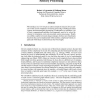Free Online Productivity Tools
i2Speak
i2Symbol
i2OCR
iTex2Img
iWeb2Print
iWeb2Shot
i2Type
iPdf2Split
iPdf2Merge
i2Bopomofo
i2Arabic
i2Style
i2Image
i2PDF
iLatex2Rtf
Sci2ools
NIPS
2000
2000
Foundations for a Circuit Complexity Theory of Sensory Processing
We introduce total wire length as salient complexity measure for an analysis of the circuit complexity of sensory processing in biological neural systems and neuromorphic engineering. Furthermore we introduce a set of basic computational problems that apparently need to be solved by circuits for translation- and scale-invariant sensory processing. Finally we exhibit a number of circuit design strategies for these new benchmark functions that can be implemented within realistic complexity bounds, in particular with linear or almost linear total wire length.
| Added | 01 Nov 2010 |
| Updated | 01 Nov 2010 |
| Type | Conference |
| Year | 2000 |
| Where | NIPS |
| Authors | Robert A. Legenstein, Wolfgang Maass |
Comments (0)

